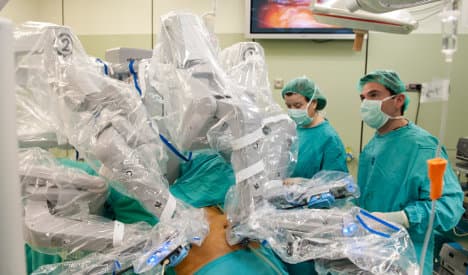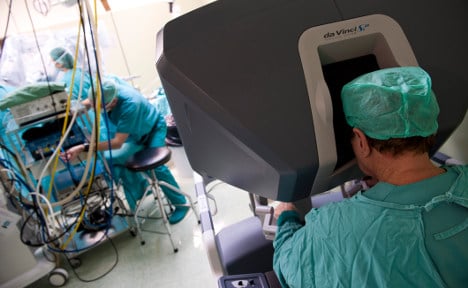Spain performs first all-robot transplant in EU

Doctors in Barcelona have successfully conducted Europe’s first transplant completely performed by robotic surgery.
A team of urologists from the Fundació Puigvert in Barcelona have successfully overseen a kidney transplant performed completely by robots, the first of its kind in all of Europe, they announced at a press conference on Thursday.
Robotic surgery is a method where surgeons control a robotic arm from a computer, allowing more precision in the procedure and reducing a patient’s recovery time as well as their chances of developing an infection.
Cameras allow doctors to see 3D images of the patient’s body as they are performing the surgery.
The team explained in a statement to The Local that the procedure had not been attempted like this before in Europe because of its complexity and specialized training requirements.
The surgery in Spain was performed last week on a 25-year-old woman named Judith, who has Alport syndrome - a genetic disorder that can lead to kidney failure. One of her kidneys had stopped functioning properly in 2009 and she needed a transplant, according to newspaper El Pais.

A Fundació Puigvert surgeon controlling the surgical robot in a separate procedure.
The technology had previously been used in Italy to perform part of a surgery, but this was the first time in Europe that an entire transplant was conducted with the robotic arm.
The surgery lasted six hours and took two teams of surgeons working simultaneously to transplant a kidney from the patient’s mother into Judith.
The group said in a statement to The Local that the use of the robot reduces the need for blood transfusions, lessens the pain felt after the operation, "minimizes complications and speeds up the patient's recovery".
"Open surgery is traumatic for the patient and for the surgeon," said the team’s director of urological services Humberto Villavicencio. "This is an effective technique for professionals because it allows us to replicate our actions with precision. You have vision in 3D and it eliminates physiological tremors, which are often enhanced when we use magnifying glasses."
The surgery also means the patient will spend less time in hospital recuperating.
“I have a little discomfort, but I can tolerate it. After the second day, it’s gotten better,” said patient Judith, who reportedly put off having the surgery to finish her exams and graduate as a primary school teacher.
The medical experts said they hoped the surgery would set a precedent for future operations.
"This is a method that is standardized and reproducible," said one of the lead surgeons, Alberto Breda. "Any kidney transplant surgeon can learn the technique and get behind the wheel of the console."
Comments
See Also
A team of urologists from the Fundació Puigvert in Barcelona have successfully overseen a kidney transplant performed completely by robots, the first of its kind in all of Europe, they announced at a press conference on Thursday.
Robotic surgery is a method where surgeons control a robotic arm from a computer, allowing more precision in the procedure and reducing a patient’s recovery time as well as their chances of developing an infection.
Cameras allow doctors to see 3D images of the patient’s body as they are performing the surgery.
The team explained in a statement to The Local that the procedure had not been attempted like this before in Europe because of its complexity and specialized training requirements.

A Fundació Puigvert surgeon controlling the surgical robot in a separate procedure.
The technology had previously been used in Italy to perform part of a surgery, but this was the first time in Europe that an entire transplant was conducted with the robotic arm.
The surgery lasted six hours and took two teams of surgeons working simultaneously to transplant a kidney from the patient’s mother into Judith.
The group said in a statement to The Local that the use of the robot reduces the need for blood transfusions, lessens the pain felt after the operation, "minimizes complications and speeds up the patient's recovery".
"Open surgery is traumatic for the patient and for the surgeon," said the team’s director of urological services Humberto Villavicencio. "This is an effective technique for professionals because it allows us to replicate our actions with precision. You have vision in 3D and it eliminates physiological tremors, which are often enhanced when we use magnifying glasses."
The surgery also means the patient will spend less time in hospital recuperating.
“I have a little discomfort, but I can tolerate it. After the second day, it’s gotten better,” said patient Judith, who reportedly put off having the surgery to finish her exams and graduate as a primary school teacher.
The medical experts said they hoped the surgery would set a precedent for future operations.
"This is a method that is standardized and reproducible," said one of the lead surgeons, Alberto Breda. "Any kidney transplant surgeon can learn the technique and get behind the wheel of the console."
Join the conversation in our comments section below. Share your own views and experience and if you have a question or suggestion for our journalists then email us at [email protected].
Please keep comments civil, constructive and on topic – and make sure to read our terms of use before getting involved.
Please log in here to leave a comment.